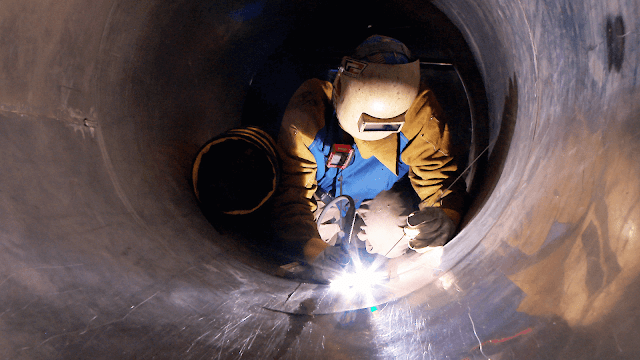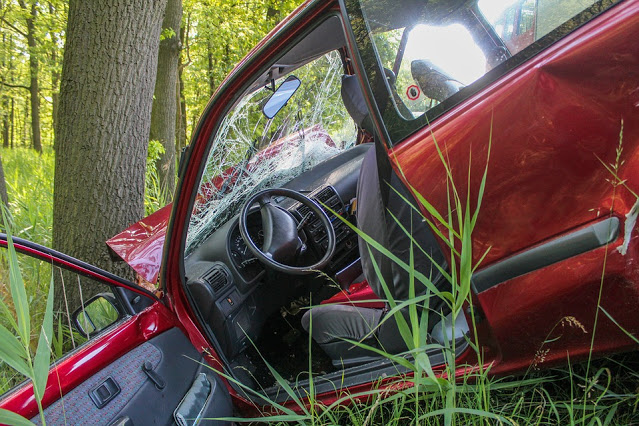Safety Talks: Confined Space Hazards and Risk Controls
Confined Space is a narrow place with limited access and egress
where workers from some high demand service or manufacturing industry are
required to work, sectors such as construction, oil and gas fields, refineries,
manufacturing plants, and petrochemicals might require high frequency of
confined space work, activities such as cleaning, maintenance, repair and installation
can be done inside a confined space based on the job requirement.
 |
| Welding Activity at the Confined Space (Pipeline) |
Confined space is not designed to be continuously occupied by job
performers, there can be a long list of the confined space examples, however
here I define some common ones which are found in residential construction may
include manholes sewer systems, storm drains, precast concrete, old units transformer,
vaults, tanks, pits, crawl spaces and attics, a space may also be a permit
required confined space if it has one or more of the following hazardous
conditions, if contains a hazardous atmosphere, contains material that has
potential to engulf or suffocate workers as a layout that might trap a worker through
converging walls or a sloped floor or has any other serious safety or health
hazard.
 |
| Confined Space Tanks at a Paint Manufacturing Plant contains White Spirit 10 Tons Dual Containers |
Workers operating in confined spaces can face life-threatening
hazards including atmospheres where there is oxygen deficiency or enrichment caused
by displacement of air by another gas, hazardous levels of toxic gases and
vapors such as carbon monoxide, carbon dioxide, hydrogen sulfide or smoke flammable
and explosive atmospheres which can arise from the presence of flammable
liquids or gases in a confined space, mechanical, electrical or physical hazards
such as moving mechanical parts, electrical shock or excessive heat flowing
liquid that can flow into the confined space causing drowning, suffocation or
other injury, extreme heat that may impede a worker from exiting the space
without assistance due to heat stress because confined spaces can present very
hazardous conditions steps must be taken to protect workers if they work in
permit required confined spaces, before any worker can enter a confined space
pre-entry planning must be conducted including having a competent person,
identify any confined space on the jobsite and determine whether these spaces
are permit required confined spaces.
If the job site contains a permit required space any worker that
must enter that space must be protected from potential hazards in the permit
space keep in mind the construction work can create confined spaces even if
there are none at the start of a project to effectively control hazards
associated with confined spaces, a confined space program must be developed and
following the program should identify precautions to be taken to protect the
workers in the permit space, how workers will be trained to perform their
duties safely and the methods to use to isolate and control hazards and how
injured workers will be promptly and safely rescued from the confined space,
the permit to work document also establishes the system for repairing using and
cancelling entry permits which are written documents that allow and control
entry into permit spaces and are issued by employers who have workers entering
these confined spaces after confined spaces on the jobsite have been identified,
workers must understand their existing location and the dangers posed by permit
required spaces and that they cannot enter these spaces without authorization workers
involved in entering permit required confined space must also understand the
potential hazards in these spaces and the methods used to isolate and control
hazards so they can perform their duties safely.
 |
| Alkyd Plant Confined Space Tanks contains Emulsion Solution |
There are three categories of workers that have specific duties
whenever work is performed in a permit required confined space authorized
entrance who are workers allowed to enter a permit space, attendants who are
workers stationed outside the permit space charged with monitoring conditions
within this space and preventing unauthorized entry, and entry supervisors who
are responsible for overseeing entry operations. Before workers can enter a
confined space employers must provide pre entry planning, this includes
identifying the means of entry and exit and proper ventilation methods in the
space ensuring that the air in a confined space is tested before workers enter
for oxygen levels flammable and toxic substances and stratified atmospheres, effective
communication is important because there can be multiple contractors operating
on a site each with its own workers meaning to enter the confined space an
attendant should be stationed outside the confined space to monitor personnel
entry, unauthorized workers cannot enter a confined space.
It’s seen that rescue attempts by untrained personnel can lead to
multiple deaths, employers should assess the worksite to determine what
personal protective equipment or PPE is needed to protect workers employers should
provide workers with the required PPE and proper training on its use and inform
them about any related hazards before the work starts it's also important to
have a pre-planned rescue strategy in case of a confined space emergency the
confined space program must include procedures for entrance to be rescued in a
timely manner by qualified personnel, an estimated 60% of fatal accidents are
untrained workers attempting the rescue, emergency responders shall be trained
and equipped, to conduct confined space rescues emergency responders should
have the adequate equipment for rescues such as an atmospheric monitors fall protection
and extraction equipment and self-contained breathing apparatus (SCBA) for the
particular permit required confined space the rescue plan should include access
strategies for ingress and egress, a project site plan and GPS coordinates if
in a remote location failure to understand the hazards of confined spaces can
lead to death or serious injury unless you are trained.


hi
ReplyDelete